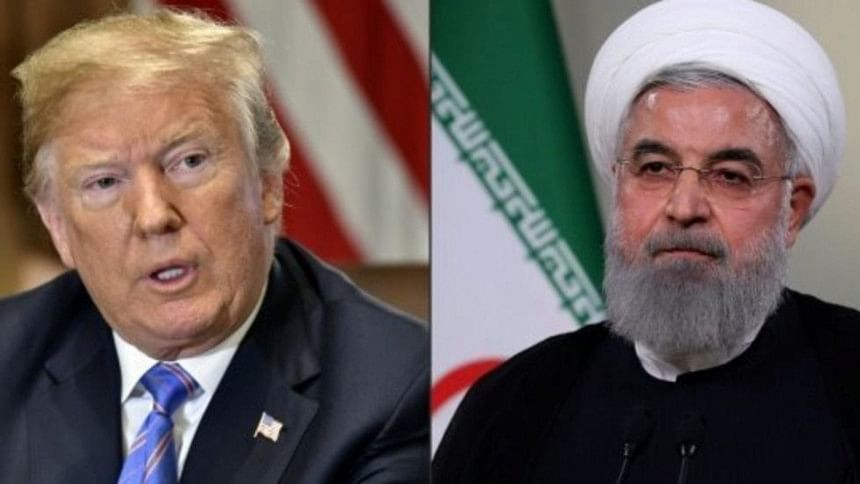Iran and the USA don’t have to be enemies

The contradict-ion couldn't be more striking.
In the immediate aftermath of 9/11, when the USA was planning its Afghanistan invasion against the Taliban government, it chose Pakistan's military establishment as its ally and made Pakistan the base of the whole operation. The fact that the Inter-Services Intelligence (ISI), the premier intelligence agency of Pakistan, was the Taliban's chief patron right from its birth, was conveniently ignored.
Similarly, during its invasion of Iraq in March 2003, Saudi Arabia became America's closest ally and its operational base, a country that had been pouring in hundreds of millions of dollars in Afghanistan and other countries to promote terrorism, puritanical Islam and a global Jihad against the West, not to mention that Osama bin Laden and most of the 9/11 hijackers were Saudi nationals.
In both countries, Iran—being opposed to the Taliban's Sunni version of Islam and Iraq's Saddam regime—offered useful intelligence and other assistance to the USA, a gesture that was never reciprocated. On the contrary, in January 2002, US President George W Bush made his "Axis of Evil" State of the Union Address blaming Iran, among others, of sponsoring terrorism and seeking weapons of mass destruction. Iran—strategically located, technologically the most advanced nation in the region after Israel and with a large petroleum reserve—became America's enemy number one.
History shows that while Iran considered the USA as an ally right from the start, successive American governments increasingly adopted hostile attitudes towards it, and aligned with the historical colonial interests of Britain and other Western countries, contradicting the popular sentiment in Iran. This became obvious in 1953 when the CIA orchestrated a coup d'état and deposed the popular government of Mohammad Mosaddegh (Iranian Prime Minister from 1951 to 1953) as he was trying to nationalise Iran's oil industry. Instead, they installed Mohammad Reza Shah, a loyal American client who ruled Iran with an iron fist for the next 26 years. Iranians no doubt were deeply offended and realised that the USA was only continuing the role Britain and France had been playing all along in the Middle East.
From 1979 to 1981, a number of events changed the course of USA-Iran relations forever. First, in January 1979, an Islamic Revolution took place under the leadership of the late Ayatollah Khomeini, forcing Mohammad Reza Shah to flee. This was followed by the proclamation of the Islamic Republic of Iran in April of that year. Then, the US Embassy in Tehran was taken over by protesters in November with 52 hostages inside, to be released only after a long 444 days in January 1981, but not before the disastrous failure of a US rescue mission, Operation Eagle Claw, involving the death of eight American servicemen in the deserts near Tabas in the South Khorasan Province of Iran. The embassy hostage incident led to American sanctions against Iran. The UN and EU imposed similar sanctions at a later date in order to deter Iran from its nuclear development programme.
In July 1988, USA shot down an Iranian passenger aircraft in the Gulf, killing all 290 persons on board.
The relations between the two countries saw some brief improvements in September 2013 when Iran's president Hassan Rouhani and US President Barack Obama spoke over phone—the first such top-level conversation in more than 30 years. Then in 2015, after a flurry of diplomatic activity, Iran signed a long-term deal on its nuclear programme with a group of world powers known as the P5+1—the US, UK, France, China, Russia and Germany—and agreed to limit its nuclear activities in return for the lifting of economic sanctions.
However, in May 2018, President Trump abandoned the deal and re-imposed even tighter sanctions on Iran, leading to increased tensions in the region, culminating in the assassination of Qasem Soleimani, the architect of Iran's overseas proxy wars and a widely popular figure in Iran.
Iran's security concerns are rooted in its history. In 1747, Ahmed Shah Durrani united the Pashtun tribes and founded an independent Afghanistan, breaking away from its Persian masters. Then in the 19th century, the Russian Czar scooped up Dagestan, Azerbaijan and parts of Armenia from Persian control. During the Second World War, Iran was lucky to have escaped breaking up, unlike its Arab neighbours, by the world powers. Iran's current security concerns are by no means unfounded, as David Dunn discusses in "'Real men want to go to Tehran': Bush, Pre-emption and the Iranian Nuclear Challenge" (International Affairs, January 2007). Dunn provides ample evidence of Iran being the real target behind America's Iraq mission in 2003.
After the Islamic Revolution in 1979 and the subsequent sanctions by the USA, EU and UN, Iran was practically isolated. The Iran of that time might have had the ideology of exporting the Islamic revolution, but it soon evaporated when it was attacked by Iraq. The eight-year-long brutal war brought Iran's security concerns to ground realities as it realised that protecting territorial integrity and economic and security interests are much more important than an Islamic revolution, despite what its anti-USA rhetoric might suggest.
However, years later, Bush Jr's "Axis of Evil" speech infuriated the Iranian leadership.
Tehran started following a strategy of creating hostile environments for foreign forces that are opposed to it by building political alliances with various state and non-state actors and actively supporting them with funds, arms, training and intelligence. In Iraq, it sent Quds personnel and supported the militia groups that carried out sustained attacks on US troops and their allies, on an average of three per day every day for five years, until US withdrawal in 2011. In Lebanon, Iran formed a key alliance with Hezbollah against Israel and other associated militias. In Syria, it salvaged the regime of Bashar Al Assad so that the supply line to Hezbollah, the Shia group in Lebanon, would not be cut off. In Yemen, Iran supported the Houthi rebels against the government that was backed by Saudi Arabia, USA, France and other Arab countries. In each case, Tehran has made clever use of sectarian tensions and its presence on the ground through Hezbollah and IRGC (Islamic Revolutionary Guard Corps, an elite Iranian security outfit) men. In response to Bush's rhetoric, Iran has created an "Axis of Resistance", an elaborate network of defense across the region, stretching from the Western borders of Afghanistan to the Mediterranean, against its historical rivals Saudi Arabia and Turkey, making it difficult for any country to sustain supporting them.
The success of this strategy is clearly evident in Iraq. As the US created a power vacuum by eliminating Saddam Hossain, Iran was quick to fill it up through its network of allies. It was again Iran that called in the Russian Air Force in Syria to its own benefit and saved Assad's regime from imminent collapse. Iran's once top strategist Qasem Soleimani successfully blended state machinery with insurgent organisations, and this trend will continue in the foreseeable future. With the assassination of Soleimani, Iran is likely to become even more nationalistic and determined, making any war in the region impossible to end.
America's choice of allies is guided by its long-term interests and goals, especially those of the defense and oil industries. As it appears, in the case of the Middle East, the preference is continuation of the conflicts rather than diffusion. Arguably, a non-hostile American relationship with Iran might actually serve this purpose better. Mega contracts for modernising Iran's oil and defense industries will be the much-coveted prize for winning a war against Tehran. But as this is less likely to happen in the foreseeable future, a friendly Iran may be a better option for Washington.
Sayeed Ahmed is a consulting engineer with experience in infrastructure project management in South Asia.

 For all latest news, follow The Daily Star's Google News channel.
For all latest news, follow The Daily Star's Google News channel. 



Comments